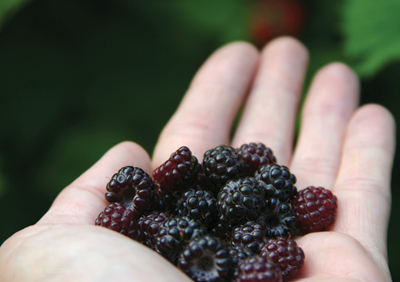
Features
Production
Research
Growing berries for optimum health benefits
March 27, 2009 By Fruit & Vegetable
Black raspberries contain cancer-fighting properties, but how much
those compounds benefit the consumer may depend on environmental
factors and cultural practices, according to Ohio State University
research.
 |
|
| Research at Ohio State University suggests that phytonutrient properties of black raspberries may be influenced by how the crop is grown and harvested and by the environmental and soil conditions present at the growing site.
|
Black raspberries contain cancer-fighting properties, but how much those compounds benefit the consumer may depend on environmental factors and cultural practices, according to Ohio State University research.
Small-fruit specialists with the Ohio Agricultural Research and Development Center analyzed four common black raspberry cultivars at eight production sites throughout Ohio and found varying levels of antioxidants. The findings suggest that phytonutrient properties may be influenced by how the crop is grown and harvested and by the environmental and soil conditions present at the growing site.
The study, “Antioxidant Capacity and Phenolic Antioxidants of Midwestern Black Raspberries Grown for Direct Markets Are Influenced by Production Site,” was published in a recent issue of the journal of HortScience.
Joe Scheerens, OARDC horticulture and crop science researcher, said the findings might help growers produce berries with optimum cancer-fighting compounds, both for use in medical studies as well as for purchase by the general consumer.
“If you are going to create clinical products used to treat degenerative diseases, one of the things that becomes paramount is to have a consistent supply of berries with a reproducible amount of bioactive ingredients,” said Scheerens, who is part of a “crop to clinic” research project at Ohio State using berries to prevent or slow the development of certain cancers of the mouth, throat and digestive tract. “In addition, if we understand how the plant reacts to cultural or environmental stresses, we can couple this information with current medical research to guide farmers on how to produce berries that provide the optimum health benefits.”
Schereens and his colleagues speculate that environmental stresses such as heat, light and water availability play a big role in antioxidant production and at what levels.
“The plants don’t produce the antioxidants for us. Anytime the plants feel stressed, they make antioxidants,” said Scheerens. “But how a plant like the black raspberry reacts to environmental conditions is complex and involves the regulation of genes that control the production of plant products like antioxidants. It’s this process we are still trying to learn more about.”
Too much stress, however, can be a bad thing. Researchers found that at production sites where the soil temperature was consistently high, antioxidant levels were the lowest.
“It could be that the stress from consistently high soil temperatures is too much for the plant to overcome and antioxidant accumulation is actually inhibited,” said Scheerens, whose team is currently conducting research to verify its preliminary findings.
Researchers also found that the state of fruit “ripeness” has an impact on antioxidant content, suggesting that harvest timing is important in determining levels of phytonutrients available in the fruit.
“Site to site variability in antioxidant levels also seemed to be related to differences in fruit ripeness at harvest as estimated by the levels of sugars and acids we measured,” said Scheerens. “When we explored this relationship with additional research, we found that anthocyanins, the pigments that are the primary antioxidants in black raspberries, increased as much as 15 per cent as the berries progressed through the last two stages of ripening.”
Scheerens said that these two stages were separated by 48 hours or less and could be distinguished only by the “finger force” required to remove the berry.
“Agricultural scientists now have ample evidence that relationships among cultivars, growing conditions, cultural practices, and post-harvest conditions affect the antioxidant levels in many fruit and vegetable crops,” said Scheerens. “It will take several years of research to obtain a clear picture of these events, but we know from our initial studies that it will be important to do so. In black raspberries, we are just beginning to unravel this story, and it will be an interesting journey.”
The cultivars Bristol, Jewel, MacBlack, and Haut were used in the study.
To learn more about functional foods and how they can enhance health and quality of life, log on to Ohio State University’s Center for Advanced Functional Foods Research and Entrepreneurship (CAFFRE) at http://fst.osu.edu/caffre/. ❦
Print this page